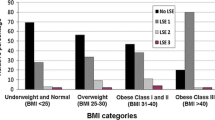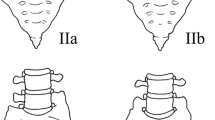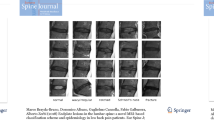Abstract
Purpose
To investigate the frequency and distribution of end plate marrow signal intensity changes in an asymptomatic population and to correlate these findings with patient age and degenerative findings in the spine.
Materials and methods
MR imaging studies of the lumbosacral (LS) spine in 59 asymptomatic subjects were retrospectively reviewed by 2 musculoskeletal radiologists to determine the presence and location of fat-like and edema-like marrow signal changes about the end plates of the L1-2 through L5-S1 levels. The presence of degenerative changes in the spine was recorded as was patient age. Descriptive statistics were utilized to determine the frequency and associations of end plate findings and degenerative changes in the spine. Interobserver variability was determined by a kappa score. Binomial probability was used to predict the prevalence of the end plate changes in a similar subject population. The Fisher exact test was performed to determine statistical significance of the relationship of end plate changes with degenerative changes in the spine, superior versus inferior location about the disc and age of the patient population.
Results
Focal fat-like signal intensity adjacent to the vertebral end-plate was noted in 15 out of 59 subjects by both readers, and involved 38 and 36 out of 590 end plates by readers 1 and 2, respectively. Focal edema-like signal intensity adjacent to the vertebral end plate was noted in 8 out of 59 subjects by both readers and involved 11 and 10 out of 590 end plates by readers 1 and 2, respectively. Either fat or edema signal intensity occurred most often at the anterior (p<.05) aspects of the mid-lumbar spine and was seen in an older sub-population of the study (p<.05).
Conclusion
End plate marrow signal intensity changes are present in the lumbar spine of some asymptomatic subjects with a characteristic location along the spine and in vertebral end plates.



Similar content being viewed by others
References
Coventry MB (1969) Anatomy of the intervertebral disk. Clin Orthop 67:9–15
Modic MT, Masaryk TJ, Ross JS, Carter JR (1988) Imaging of degenerative disk disease. Radiology 168:177–186
Modic MT, Steinberg PM, Ross JS, Masaryk TJ, Carter JR (1988) Degenerative disk disease: assessment of changes in vertebral body marrow with MR imaging. Radiology 166:193–199
Weishaupt D, Zanetti M, Hodler J, Min K, Fuchs B, Pfirrmann CW, Boos N (2001) Painful lumbar disk derangement: relevance of endplate abnormalities at MR imaging. Radiology 218:420–427
Toyone T, Takahashi K, Kitahara H, Yamagata M, Murakami M, Moriya H (1994) Vertebral bone-marrow changes in degenerative lumbar disc disease. An MRI study of 74 patients with low back pain. J Bone Joint Surg Br 76:757–764
Bram J, Zanetti M, Min K, Hodler J (1998) MR abnormalities of the intervertebral disks and adjacent bone marrow as predictors of segmental instability of the lumbar spine. Acta Radiol 39:18–23
Powell MC, Wilson M, Szypryt P, Symonds EM, Worthington BS (1986) Prevalence of lumbar disc degeneration observed by magnetic resonance in symptomless women. Lancet 2:1366–1367
Boden SD, Davis DO, Dina TS, Patronas NJ, Wiesel SW (1990) Abnormal magnetic-resonance scans of the lumbar spine in asymptomatic subjects. A prospective investigation. J Bone Joint Surg Am 72:403–408
Jensen MC, Brant-Zawadzki MN, Obuchowski N, Modic MT, Malkasian D, Ross JS (1994) Magnetic resonance imaging of the lumbar spine in people without back pain. N Engl J Med 331:69–73
Stadnik TW, Lee RR, Coen HL, Neirynck EC, Buisseret TS, Osteaux MJ (1998) Annular tears and disk herniation: prevalence and contrast enhancement on MR images in the absence of low back pain or sciatica. Radiology 206:49–55
Weishaupt D, Zanetti M, Hodler J, Boos N (1998) MR imaging of the lumbar spine: prevalence of intervertebral disk extrusion and sequestration, nerve root compression, end plate abnormalities, and osteoarthritis of the facet joints in asymptomatic volunteers. Radiology 209:661–666
Ricci C, Cova M, Kang YS, Yang A, Rahmouni A, Scott WW Jr, Zerhouni EA (1990) Normal age-related patterns of cellular and fatty bone marrow distribution in the axial skeleton: MR imaging study. Radiology 177:83–88
Bernick S, Cailliet R (1982) Vertebral end-plate changes with aging of human vertebrae. Spine 7:97–102
Jones MD, Pais MJ, Omiya B (1988) Bony overgrowths and abnormal calcifications about the spine. Radiol Clin North Am 26:1213–1234
Miller JA, Schmatz C, Schultz AB (1988) Lumbar disc degeneration: correlation with age, sex, and spine level in 600 autopsy specimens. Spine 13:173–178
Barozzi L, Olivieri I, De Matteis M, Padula A, Pavlica P (1998) Seronegative spondylarthropathies: imaging of spondylitis, enthesitis and dactylitis. Eur J Radiol 27 [Suppl 1]:S12–17
Jevtic V, Kos-Golja M, Rozman B, McCall I (2000) Marginal erosive discovertebral “Romanus” lesions in ankylosing spondylitis demonstrated by contrast enhanced Gd-DTPA magnetic resonance imaging. Skeletal Radiol 29:27–33
Ünsal E, Arici AM, Kavukçu S, Pirnar T (2002) Andersson lesion: spondylitis erosiva in adolescents. Two cases and review of the literature. Pediatr Radiol 32:183–187
Author information
Authors and Affiliations
Corresponding author
Rights and permissions
About this article
Cite this article
Chung, C.B., Vande Berg, B.C., Tavernier, T. et al. End plate marrow changes in the asymptomatic lumbosacral spine: frequency, distribution and correlation with age and degenerative changes. Skeletal Radiol 33, 399–404 (2004). https://doi.org/10.1007/s00256-004-0780-z
Received:
Revised:
Accepted:
Published:
Issue Date:
DOI: https://doi.org/10.1007/s00256-004-0780-z




